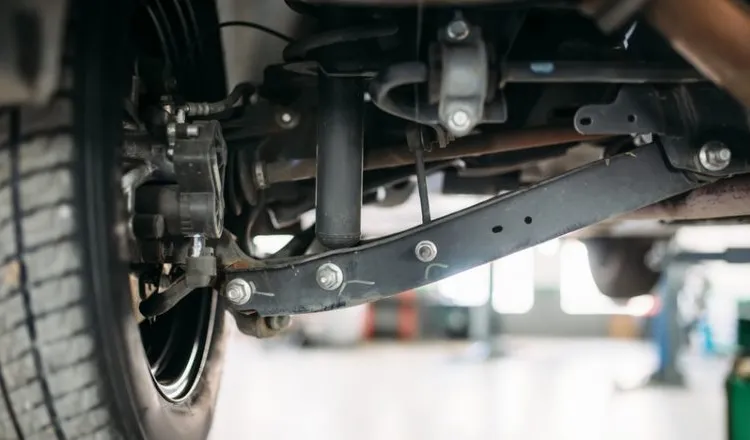Car suspension types systems play a key role in how a vehicle handles, rides, and absorbs bumps. At a basic level, these systems fall into two main categories: independent and dependent suspension. Independent suspension ( MacPherson Strut . Double Wishbone . Multi-link . Trailing Arm ) allows each wheel to move separately, improving ride comfort and handling—perfect for everyday cars and sporty models. On the other hand, dependent suspension ( . Leaf Spring . Solid Axle (Rigid Axle). Other Suspension Types:
. Air Suspension . Semi-Independent Suspension . Electronic Suspensions ) connects both wheels on the same axle, offering strength and stability, especially useful for larger vehicles like trucks and vans. Within these two main categories, there are several designs like MacPherson struts, multi-link setups, and even air suspension, each with its own pros and cons. In this guide, we’ll explore the most common suspension systems, how they work, and why certain types are chosen for different vehicles—from family hatchbacks to heavy-duty pickups.
Purpose of Car Suspension
Car suspension serves a crucial role beyond the mere attachment of tires to the chassis. It plays a pivotal role in guiding the wheels and ensuring stability during various road conditions. To achieve this, components like wishbones or rods are strategically installed. These parts must strike a balance—being resilient enough to withstand challenges such as driving over potholes while not impeding the car’s steering capabilities excessively.
In addition to stability, car suspension is responsible for springing and amortizing the vehicle. This directly influences driving comfort and safety. The integration of shock absorbers and springs into the suspension system is essential. The suspension system’s ability to effectively absorb shocks and vibrations contributes significantly to a smoother and safer driving experience.
The car’s suspension system must navigate diverse road scenarios, necessitating innovative solutions from automotive manufacturers. As a result, the suspension system is designed not only to provide stability but also to dynamically respond to different driving conditions. It’s a sophisticated mechanism that ensures the vehicle remains responsive to the driver’s commands while delivering a comfortable and safe ride.
Key Points:
- Components like wishbones and rods provide stability and maneuverability.
- The suspension system is not only about attaching tires but also about adapting to diverse road situations.
- Shock absorbers and springs are integrated to enhance driving comfort and safety.
- The system must be stable while remaining responsive to the driver’s inputs.
Types of Suspension Systems
In the realm of automotive engineering, suspension systems are diverse, each serving specific functions to enhance the overall driving experience. These systems can be categorized based on their structure, and the three primary types are dependent suspension, independent suspension, and semi-independent suspension.
A. Dependent Suspension
- Description and Characteristics: Dependent suspension, often referred to as a “stiff bridge,” operates on the principle that the movement of one wheel on an axle directly influences the other.
- Interconnected Movement: When one wheel encounters bumps or irregularities, the connected wheel experiences a corresponding effect.
B. Independent Suspension
- Description and Characteristics: Independent suspension, in contrast, allows each wheel to move independently of the other. The MacPherson strut is an example of this design, which is particularly popular in sports cars.
- No Interference: The movement of one wheel does not affect the performance or movement of the other, offering improved maneuverability and responsiveness.
C. Semi-Independent Suspension
- Intermediate Solution: Semi-independent suspension strikes a balance between dependent and independent systems. While one wheel’s movement can influence the other to some extent, the impact is limited.
- Torsion Beam Application: This type of suspension often utilizes a torsion beam to provide a controlled level of interconnected movement.
Understanding these fundamental suspension structures lays the groundwork for exploring more sophisticated systems designed to cater to specific driving conditions and preferences. Each type has its advantages and limitations, influencing its application in various vehicle models.
As we delve deeper into the intricacies of suspension systems, it becomes evident that the automotive industry’s commitment to innovation continually shapes the driving experience. Whether it’s the seamless interconnectedness of dependent suspension or the enhanced agility offered by independent suspension, engineers strive to strike the perfect balance between comfort and performance. The evolving landscape of automotive design ensures that suspension systems will continue to evolve, providing drivers with safer, smoother rides.
Further Suspension Classifications
The realm of suspension systems extends beyond structural classifications, encompassing hydraulic and pneumatic technologies that contribute to varying driving experiences.
- Hydraulic and pneumatic suspension:
- Hydraulic Suspension:
The hydraulic suspension system operates by allowing users to adjust the height of the car’s suspension through hydraulic actuators, replacing traditional shock absorbers. This feature is particularly useful for optimizing the vehicle’s ground clearance based on different road conditions. - Hydropneumatic Suspension:
Manufacturers like Citroen and Renault use hydropneumatic suspension, a hybrid solution. This system combines hydraulic and pneumatic elements to provide users with the ability to freely lower or raise the car’s structure. The adaptability to diverse road conditions makes it a favored choice, offering a balance between comfort and control. - Air Suspension:
Air suspension, an increasingly popular innovation in higher-class cars, operates solely on air and pressure. Brands such as BMW, Audi, and Mercedes have embraced this technology, which effectively eliminates even the slightest shocks and vibrations. Modern air suspension systems leverage computer technology to read speed and road conditions, dynamically adjusting the car’s firmness or softness for an optimal driving experience.
Incorporating these advanced suspension technologies not only enhances the overall driving experience but also underscores the continuous evolution of automotive engineering. As manufacturers explore new solutions, drivers can anticipate further refinements in comfort, safety, and adaptability on the road. Understanding these classifications empowers car enthusiasts to appreciate the nuances that contribute to the dynamic performance of their vehicles.
Importance of Suspension Maintenance
The maintenance of a car’s suspension system is paramount to ensuring optimal driving comfort and safety. Neglecting this crucial aspect can lead to a host of issues, affecting both the vehicle’s performance and the safety of its occupants.
Regular care for the entire suspension system is essential to prevent wear and tear, ensuring that the car operates smoothly and efficiently. Here are key points highlighting the importance of suspension maintenance:
- Driving Comfort and Stability:
- Well-maintained suspension components contribute to a smoother ride.
- Reduced vibrations and shocks enhance overall driving comfort.
- Proper maintenance prevents unusual sounds or sensations while driving.
- Safety Considerations:
- A properly functioning suspension system is vital for maintaining control of the vehicle.
- Suspension issues can compromise handling, leading to safety hazards.
- Regular maintenance reduces the risk of accidents and enhances overall road safety.
- Periodic Diagnostic Inspections:
- A damaged suspension can lead to a failed diagnostic inspection.
- Routine checks and timely repairs ensure compliance with inspection requirements.
- Addressing issues promptly prevents more extensive damage and costly repairs.
- Prevention of Severe Failures:
- Neglecting suspension maintenance can result in severe failures.
- Critical components may break or malfunction, leading to hazardous situations.
- Regular inspections and repairs serve as preventive measures against catastrophic failures.
- Wheel Integrity:
- A well-maintained suspension system contributes to the stability of the wheels.
- Prevents scenarios where wheels might break off due to suspension failure.
- Ensures the longevity and reliability of the entire wheel assembly.
To maintain a car’s suspension system effectively, owners should heed the advice of automotive professionals, perform regular visual inspections, and address any concerns promptly. By investing time and resources in suspension maintenance, drivers can enjoy a smoother ride, ensure their safety on the road, and extend the lifespan of their vehicle.
Conclusion
In conclusion, the suspension system stands as a critical component within the automotive realm, establishing a pivotal connection between a car’s wheels and its structural framework. The constant search for improved driving comfort and safety has driven the evolution of suspension systems. As we’ve explored the various types of suspension systems, it becomes evident that these mechanisms go beyond merely attaching tires to the chassis.
- Importance of Suspension Maintenance:
Regular care for the entire suspension system emerges as a paramount consideration. Neglecting this essential component not only jeopardizes driving comfort but also poses significant risks to safety. Therefore, taking preventative measures and adhering to routine maintenance routines are crucial. - Impact on Driving Comfort and Safety:
The pivotal role of the suspension system in guiding wheels and ensuring stability cannot be overstated. Components such as wishbones and rods contribute to the stability and maneuverability of the vehicle. Simultaneously, the incorporation of shock absorbers and springs plays a pivotal role in springing and amortizing, influencing driving comfort and overall safety. - Prevention of Issues During Periodic Diagnostic Inspections:
Regular maintenance becomes particularly significant during periodic diagnostic inspections. A well-maintained suspension system ensures a smooth passage through these assessments, preventing potential issues from arising and, in extreme cases, causing severe failures. - Consequences of Severe Failures:
It’s imperative to understand that neglecting suspension maintenance could lead to dire consequences. In extreme scenarios, a failure in the suspension system may even result in the detachment of a wheel, posing grave risks to both the vehicle and its occupants.
In essence, by proactively replacing damaged components indicated by a diagnostician, closely observing the vehicle on the road, and listening for any abnormal sounds, drivers can actively contribute to a smoother, safer driving experience. This conscientious approach is not just a recommendation; it is a pathway to driving with tranquility and ensuring the well-being of both the vehicle and its passengers.



Pingback: LPG installations in cars: everything you need to know before installation - Buying new and used cars online, and read expert Car review
Pingback: Alternative fuels vehicles: what can we put in the tank? - Buying new and used cars online, and read expert Car review
Pingback: Mastering Engine RPM in Cars: Essential Guide to Performance, Fuel Efficiency, and Maintenance - Buying new and used cars online, and read expert Car review